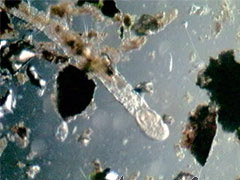Aquatic Earthworm (Annelida) Videos
As aquatic members of the class Oligochaeta in the phylum Annelida, aquatic earthworms are not an oxymoron, but rather relatively pollution-tolerant worms. They are typically found in and near the soft sediments of ponds, ditches, and wetlands. In common with other members of the microannelids, aquatic earthworm species feature tufts or bristles known as setae on their body segments, which facilitate tunneling through decomposing organic matter and bottom soils.

As aquatic members of the class Oligochaeta in the phylum Annelida, aquatic earthworms are not an oxymoron, but rather relatively pollution-tolerant worms. They are typically found in and near the soft sediments of ponds, ditches, and wetlands. In common with other members of the microannelids, aquatic earthworm species feature tufts or bristles known as setae on their body segments, which facilitate tunneling through decomposing organic matter and bottom soils.
Aquatic Earthworm Video #1
This annelid ingests a food morsel, after which it is seen passing through the translucent body; under oblique illumination with a playing time of 39 seconds. Choose a playback format that matches your connection speed:
Aquatic Earthworm Video #2
A worm nearly ties itself into a knot in an apparent struggle with a piece of debris; under oblique illumination with a playing time of 23 seconds. Choose a playback format that matches your connection speed:
Aquatic Earthworm Video #3
The bristle-like setae on the body segments are seen at work as the worm searches its way through sediment and debris particles; under oblique illumination with a playing time of 29 seconds. Choose a playback format that matches your connection speed:
There are more than 200 species of aquatic earthworms in North America, and over 3,000 worldwide. Aquatic earthworms resemble their terrestrial cousins, although they are much smaller, at lengths usually ranging from 1 to 30 millimeters. Some species possess tail setae, which aid swimming. Unlike the terrestrials that cannot tolerate puddles and torrential rain events, aquatic earthworms thrive in an aqueous environment, and desiccate if denied moisture. In old activated sludge ponds utilized in sewage treatment, aquatic earthworms may become quite abundant, thriving on bacterial floc and relatively loose substrates.
Feeding on bacteria, algae, diatoms, and decaying animal and plant matter in the soft substrates, aquatic earthworms eat as they burrow. The huge volume of sediment and organic matter that cycles through the guts of these annelids speeds up nutrient recycling and physically turns over the aquatic soils, thereby increasing aquatic productivity and soil aeration. The transparent bodies of these freshwater worms provide a unique view of the internal digestive, circulatory, and reproductive systems. As with other members of the oligochaetes, the aquatic species are hermaphrodites and feature the clitellum, a darker, enlarged body segment located toward the head of the animal. After the eggs mature, a mucous tube secreted by the clitellum slides along the body as the worm moves backwards. Stored sperm and eggs are discharged into the clitellum, and fertilization is completed. As the worm passes out of the mucous tube, a cocoon forms around the fertilized eggs, serving as a "nest" until the eggs hatch. Usually, the cocoons are deposited on submerged rocks, aquatic vegetation, or debris. With direct development, the young and mature aquatic earthworms resemble each other, and provide food for other invertebrates and fishes.
